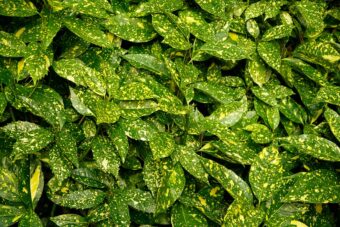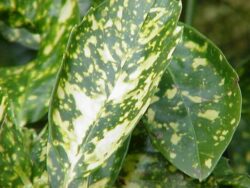In this article, we will discuss how to grow Aucuba, or spotted laurels as it is alternatively known, in containers. This wonderful, elegant shrub is a delight in your patio area. You do often see Aucubas in gardens or Japanese laurels to give its other common name, and you wonder if this plant can be grown in containers. This article is here to show you how to grow these plants in containers.

This hardy shrub tends to make short term plants in containers, as over time they will get too big and will need to be placed in the ground. It has showy leaves that are glossy and often spotted in elegant and eye-catching ways.
It is a low maintenance plant, not requiring much in the way of pruning or looking after. The most common species you are likely to find and grow is Aucuba japonica, which comes in many varieties, Some are tall growing up to 4.5m high, whilst others as much more compact, only reaching a height of 1m.
IT IS A SLOW GROWING PLANT
Aucuba is a relatively slow-growing plant, taking many years to grow up to 3m, but it will only reach these great heights if the growing conditions are right for it. They can be pruned but it is not recommended as it will make the shrub look strange and unbalanced. The taller the plant the larger the container you use needs to be.
Plant in a whiskey half-barrel full of 30% by volume horticultural grit mixed with 70% by volume multipurpose compost. You can use perlite to replace the grit with but this will make the mixture lighter and more prone for the container to blow over in gales and strong winds.
This is why I recommend horticultural grit over perlite but if you only have perlite then use it. You will need to make sure that the compost is free-draining so that the roots will not rot. Place some crocks over drainage holes and to allow excess water to drain away and place the container on legs to elevate it. This will also help the excess water to drain away.
IN AUTUMN THEY COME INTO THEIR OWN
Aucubas tend to come on their own in autumn and winter where their foliage really shines through, especially so if you under plant them with red or pink mini cyclamens or combine them with red or light coloured plants. One thing that must be stipulated is that the plant is grown in a light shade, where the leaves will look better and showier. Too much light, especially midday sun can scorch the leaves and cause them to fade. You will need to water to keep the soil slightly moist but never soggy.
The leaves tend to be the main talking point but the flowers they produce are attractive in themselves. They tend to be red and appear in autumn and winter.

In early spring make sure that you give it a feed with a slow-release fertiliser allowing the plant to starve over autumn and winter.
As mentioned before Aucuba do not like to be hard pruned, but you can give them a light prune in late winter to early spring to keep it in shape. You can at this time remove any damaged branches, dead branches and branches that look out of proportion or position.
Once the plant becomes root bound, you will need to move it to the next pot size up. This must be carried out at least once a year but eventually, it will get too big and will need to be placed in the ground.
VARIETIES TO GROW INCLUDES
There are several colourful varieties to grow and are based on the species Aucuba japonica and these include:
The pure green ‘Rozannie’, the green and yellow speckled ‘Gold Strike’, the delightful cream and green ‘Pictorola’, the serrated green and yellow spotted ‘Crotonifolia’
Other possibilities include the beautiful green and yellow ‘Variegata’ and the even more beautiful green and yellow spotted ‘Maculata’. One of the most elegant Aucuba that stands out is ‘Sparkles’ that has deep green leaves with splashes of golden yellow, which makes a great feature plant.
Aucuba tends to be diseases and pests free but watch out for these.
CONCLUSIONS
In this article, we have discussed how to grow Aucubas in containers, where to grow them, what type of compost to use, their preferred growing conditions and the varieties to grow. It is a low maintenance plant that will brighten any container display in autumn and winter. So little to do but so many beautiful colours to enjoy.
A plant for all container gardeners if you enjoy colourful foliage plants. If you have any questions or comments that you wish to make on growing Aucubas in containers, please do so in the comment box below.
Happy Aucuba growing.
